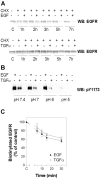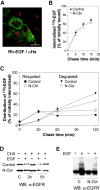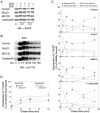Ubiquitination and proteasomal activity is required for transport of the EGF receptor to inner membranes of multivesicular bodies
- PMID: 11864992
- PMCID: PMC2173306
- DOI: 10.1083/jcb.200106056
Ubiquitination and proteasomal activity is required for transport of the EGF receptor to inner membranes of multivesicular bodies
Abstract
EGF, but not TGF alpha, efficiently induces degradation of the EGF receptor (EGFR). We show that EGFR was initially polyubiquitinated to the same extent upon incubation with EGF and TGF alpha, whereas the ubiquitination was more sustained by incubation with EGF than with TGF alpha. Consistently, the ubiquitin ligase c-Cbl was recruited to the plasma membrane upon activation of the EGFR with EGF and TGF alpha, but localized to endosomes only upon activation with EGF. EGF remains bound to the EGFR upon endocytosis, whereas TGF alpha dissociates from the EGFR. Therefore, the sustained polyubiquitination is explained by EGF securing the kinase activity of endocytosed EGFR. Overexpression of the dominant negative N-Cbl inhibited ubiquitination of the EGFR and degradation of EGF and EGFR. This demonstrates that EGF-induced ubiquitination of the EGFR as such is important for lysosomal sorting. Both lysosomal and proteasomal inhibitors blocked degradation of EGF and EGFR, and proteasomal inhibitors inhibited translocation of activated EGFR from the outer limiting membrane to inner membranes of multivesicular bodies (MVBs). Therefore, lysosomal sorting of kinase active EGFR is regulated by proteasomal activity. Immuno-EM showed the localization of intact EGFR on internal membranes of MVBs. This demonstrates that the EGFR as such is not the proteasomal target.
Figures









References
-
- Authier, F., M. Metioui, A.W. Bell, and J.S. Mort. 1999. Negative regulation of epidermal growth factor signaling by selective proteolytic mechanisms in the endosome mediated by cathepsin B. J. Biol. Chem. 274:33723–33731. - PubMed
-
- Babst, M., G. Odorizzi, E.J. Estepa, and S.D. Emr. 2000. Mammalian tumor susceptibility gene 101 (TSG101) and the yeast homologue, Vps23p, both function in late endosomal trafficking. Traffic. 1:248–258. - PubMed
Publication types
MeSH terms
Substances
LinkOut - more resources
Full Text Sources
Other Literature Sources
Research Materials
Miscellaneous

